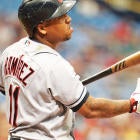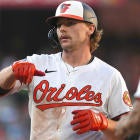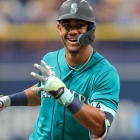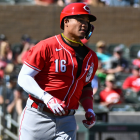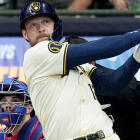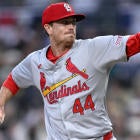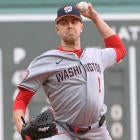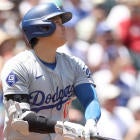Projected statistics below are per the SportsLine Rest of Season projections. Trade values were calculated per Ariel's Z-Score valuation method, and are available at SportsLine.com here, along with the Grade The Trade tool.
Need help pulling off a trade? We took questions from our podcast listeners and readers and picked six to grade, to show you how to value some of this season's most intriguing players.
Question:
From Benjamin in a 12 team 5 x 5 Roto league w/ three OF:
Give up:
Jose Ramirez
German Marquez
Will Smith (RP, SFG)
Get:
Mike Trout
Hansel Robles
Carlos Martinez
Answer:
OUTGOING | |||||||
Player | Trade Value | AB | R | RBI | HR | SB | BA |
Jose Ramirez | 23 | 357 | 60 | 57 | 17 | 20 | .266 |
Player | Trade Value | IP | W | S | K | ERA | WHIP |
German Marquez | 6 | 109 | 7 | 0 | 124 | 3.80 | 1.24 |
Will Smith | 18 | 42 | 1 | 15 | 60 | 2.57 | .88 |
Total | 47 | ||||||
Capped Total | 47 | ||||||
INCOMING | |||||||
Player | Trade Value | AB | R | RBI | HR | SB | BA |
Mike Trout | 41 | 309 | 74 | 61 | 25 | 13 | .317 |
Player | Trade Value | IP | W | S | K | ERA | WHIP |
Hansel Robles | 4 | 47 | 1 | 17 | 58 | 4.02 | 1.17 |
Carlos Martinez | -2 | 31 | 3 | 0 | 32 | 3.48 | 1.32 |
Total | 42 | ||||||
Capped Total | 44 |
Here we have an interesting 3-for-3 trade. An extreme underperforming stud is exchanged for the pre-season consensus #1 overall pick. A fantastic closer is offered for a middling closer, albeit on a far better team. The trade also includes a key Colorado Rockies strikeout pitcher, swapped for an injury prone enigma. Let's dive into it.
First to note, is that Carlos Martinez is projected to earn negative Trade value. He does not lie within the top 108 best pitchers. For the purpose of this trade valuation – I will cap his value at zero.
From an overall value perspective, per CBS SportsLine's rest-of-season projections, the trade is roughly even. The difference between Mike Trout and Jose Ramirez currently compensates for the loss of Will Smith and German Marquez. However, I might suggest that some of the outgoing players ROS stats may be on the high side.
Jose Ramirez's projection is for 17 homeruns and 20 SB. His current stolen base pace supports the lofty swipe potential. However, with only 4 HRs to date, 17 HRs seems to be an upside - rather than his expected production. Furthermore, I don't buy the 60 runs and 57 RBI, as he is a part of a now-poor Indians lineup.
I happen to love Will Smith as a reliever this season, however, his role as the closer could come to an end prior to July 31. The Giants are not contenders for 2019 and may look to sell off Smith – one of their more valuable assets. If that occurs, his projected save total would be in jeopardy. (Keep an eye out for Reyes Moronta as a possible closer candidate in SF.) As the Giants currently play in one of the more pitcher friendly ballparks in the National League, a trade would almost certainly have a negative effect on Smith's going forward ratios as well.
Given my pessimistic view on the outgoing projected figures, I believe that the trade is now in your favor.
Please keep in mind of course, that categories do matter in Rotisserie. Without context, it is hard to know the categorical impact that the trade may have on your league's standings. From a total value perspective, I believe this trade to be accretive.
Grade: B-.
Question:
From Nick:
In a 10-team head to head categories league I traded Jose Ramirez and Felipe Vasquez for Rhys Hoskins, Michael Chavis, and Fernando Tatis. I have Wade Davis coming back to fill in my closer spots. What do you guys think?!
Response:
Another Jose Ramirez trade! Let's take a look.
OUTGOING | |||||||
Player | Trade Value | AB | R | RBI | HR | SB | BA |
Jose Ramirez | 21 | 357 | 60 | 57 | 17 | 20 | .266 |
Player | Trade Value | IP | W | S | K | ERA | WHIP |
Felipe Vazquez | 9 | 41 | 1 | 19 | 60 | 2.41 | 1.20 |
Total | 30 | ||||||
INCOMING | |||||||
Player | Trade Value | AB | R | RBI | HR | SB | BA |
Rhys Hoskins | 21 | 335 | 58 | 70 | 22 | 3 | .275 |
Michael Chavis | 6 | 303 | 48 | 52 | 16 | 4 | .277 |
Fernando Tatis Jr. | 5 | 344 | 45 | 43 | 13 | 10 | .288 |
Total | 32 |
We have another case where the total value seems roughly even – and once again, I would caution that Ramirez's projection is more of an upside than an expectation. I do believe though, that Tatis' projections also seem lofty – especially since he is coming off of a bad hamstring injury.
Since this is a categories league, let's analyze the components a bit more carefully.
- BA – Ramirez's current is .206 BA, and with an unlucky .231 BABIP it should regress upwards. However, it is hard for me to peg Ramirez as a .280+ player rest of season player (and SportsLine does not either). The incoming players all have excellent averages and would replace a few low batting averages - so this is a net win. WIN
- R & RBI – Hoskins alone should make up for Ramirez's run production. Throw in other assets, and this is an easy win. WIN
- HR – Hopefully you should be able to see this as a large power gain here. Hoskins alone has legitimate full season 40 HR power. WIN
- SB – This category might be a loss. Ramirez with his 14 steals is 3rd in the AL this season. Each lineup slot that you would replace with an incoming player from this trade would likely give you fewer steals. LOSS
- W, K – With no starting pitchers being exchanged, I have to call these categories a virtual tie. DRAW
- SV – As mentioned in the question, Wade Davis would slot in for Vazquez after the trade's completion. Davis, who would be the closer on a suddenly hot Rockies team, may end up with more saves than Vazquez. However, I am a Vazquez fan, and his role is just about etched in stone. There may not be a huge loss here, but let's conservatively call this a small loss. LOSS
- ERA, WHIP – Vazquez is projected for better ratios than Davis. Closers won't affect your ratios all that much, but to me it's a clear loss. LOSS
We have a total of 4 wins, 4 losses and 2 draws here. However, the gains above are large, whereas the losses are small. The trade is a good one, with a few chances to acquire breakout players.
Grade: B.
Question:
From Mark in a 12 team standard 5x5 Head to Head Categories league.
Give up: Austin Riley & Dwight Smith
Get: Mookie Betts
Response:
OUTGOING | |||||||
Player | Trade Value | AB | R | RBI | HR | SB | BA |
Austin Riley | 3 | 299 | 43 | 51 | 14 | 2 | .271 |
Dwight Smith | 6 | 371 | 50 | 55 | 17 | 4 | .248 |
Total | 9 | ||||||
INCOMING | |||||||
Player | Trade Value | AB | R | RBI | HR | SB | BA |
Mookie Betts | 30 | 373 | 77 | 53 | 18 | 14 | .295 |
Total | 30 |
This one seems to be a quantity vs. quality trade here. Young prospects for a proven MVP caliber player.
Well, if you believe the projections, in 5x5 Roto – this one is a no-brainer. Nothing about the Mookie Betts' line looks especially odd to me.
Riley has certainly hit the ground running, so you could make the case that his expected power numbers are low. As a rookie, I would generally err on the side of caution, and consider the 14 HRs rest of season, a reasonable expectation (at least, it is within reason). If anything, I find that Dwight Smith's 17 rest of season homers season could be a tad optimistic.
In a vacuum, I would grade this trade as an A-. You are buying somewhat low on Mookie Betts and selling high on your own players. Now, if homers and RBI are tight in your league – and speed isn't a category that a boost would help you … the trade may not be of as much help. The context is always important – but on the whole, it is hard to argue with this move.
Grade: A-.
Question:
Buxton for Kepler
— Michael C. Russell (@MichaelCRussell) June 4, 2019
Response:
OUTGOING | |||||||
Player | Trade Value | AB | R | RBI | HR | SB | BA |
Byron Buxton | 9 | 321 | 52 | 51 | 12 | 12 | .259 |
INCOMING | |||||||
Player | Trade Value | AB | R | RBI | HR | SB | BA |
Max Kepler | 11 | 336 | 61 | 54 | 19 | 2 | .253 |
According to my valuation of SportsLine projections, this trade is roughly even in overall value. The players also play the same fielding positions – so it is indeed a straight swap.
This trade is completely context dependent. If an extra 10 stolen bases would help you more than a decline in power and run production – then this trade would be beneficial to you. Basically, the makeup of your fantasy team would determine the effectiveness of conducting such a transaction.
I'll go one step further and talk about risk.
Kepler, to me, is far less risky than Buxton. Buxton showed his extreme downside last season, with a .156 batting average. Buxton could be and has the potential to be a bust. Given that the Twins are contenders, a bad stretch of play will send Byron to the bench. On the other side, Buxton also owns a much higher upside. With a 16/29 season back in 2017, Buxton flashed incredible power/speed skills.
So … which is better – the stable performer like Kepler, or the risky Buxton?
The answer is – It depends on where you are in the standings. If you are in 1st or 2nd place, you likely want to reduce your risk. You don't need to jump in the standings. You should favor the larger expected values, and the side of the trade with the most certainty. If you are trailing your league by 40 points … you need to increase your team's risk – because expected production alone won't jump you into contention. In that scenario, I would favor Buxton for 20/30 attainable upside.
This is a perfect trade for a team high up in the standings with a team low down in the standings. One team reduces their risk, and the other raises it's variance. Buxton is truly the perfect example of a high variance player.
Without knowing your context though, this trade is roughly even.
Grade: C
Question:
Marquez and Bassitt for Cole
— Ian Price (@IanPric3) June 4, 2019
Response:
OUTGOING | |||||||
Player | Trade Value | IP | W | S | K | ERA | WHIP |
German Marquez | 5 | 109 | 7 | 0 | 124 | 3.80 | 1.24 |
Chris Bassitt | 1 | 93 | 8 | 0 | 90 | 3.77 | 1.30 |
Total | 7 | ||||||
INCOMING | |||||||
Player | Trade Value | IP | W | S | K | ERA | WHIP |
Gerrit Cole | 18 | 106 | 9 | 0 | 142 | 3.57 | 1.10 |
Total | 18 |
On the face of it, I would declare this trade a "no-brainer." In the NFBC 2nd chance leagues which ran over Memorial Day weekend, Gerrit Cole was the 5th pitcher selected overall according to ADP. To compare, Marquez and Bassitt's pitcher ADPs were 38 and 102, respectively – and thus, high stakes players also agree on the verdict.
The only way that I can see this trade generating any questions is the quantity over quality issue. You are giving up two pitchers and are receiving only one in return.
Bassitt has limited to no value. His stat line looks very similar to the "Archer Line" which I described in the post entitled, "Is Chris Archer Rosterable?" In the article, I demonstrated how rostering a player with these stats (decent strikeout rate, mediocre ERA, horrible WHIP) is not at all helpful to teams, and may be more efficiently replicated on the waiver wire.
Given the evidence, and since Bassitt is akin to a replacement level starting pitcher – the trade essentially becomes Marquez for Cole, which is a slam dunk.
Grade: A.
Question:
Gibson and strop receive Robles and Dietrich. 12 team h2h roto.
— SuperDuperKrueger (@KruYorkTimes) June 4, 2019
Response:
OUTGOING | |||||||
Player | Trade Value | IP | W | S | K | ERA | WHIP |
Kyle Gibson | -6 | 114 | 9 | 0 | 111 | 4.11 | 1.39 |
Pedro Strop | 6 | 33 | 1 | 20 | 36 | 3.27 | 1.18 |
Total | -1 | ||||||
Capped Total | 6 | ||||||
INCOMING | |||||||
Player | Trade Value | AB | R | RBI | HR | SB | BA |
Derek Dietrich | 19 | 349 | 57 | 60 | 21 | 2 | .284 |
Player | Trade Value | IP | W | S | K | ERA | WHIP |
Hansel Robles | 3 | 47 | 1 | 17 | 58 | 4.02 | 1.17 |
Total | 22 | ||||||
Capped Total | 22 |
We have here a two for two trade. A closer swap, plus a hitter for pitcher swap. Let's analyze this one:
The closers are essentially a wash. Strop is set to come back from injury this week, and he projects to be the better pitcher. He had a recurrence of a hamstring issue from spring training, which is mildly troubling. I worry about his health.
For now, Robles has the closer job. But with any sign of trouble, there may be a quick hook for Robles from the role. Mid to low-end closers are mostly interchangeable, so for all intents and purposes – let's call the reliever swap a wash.
Kyle Gibson's projections do not look especially odd. Gibson typically does strike out roughly a batter an inning, throws for a mediocre ERA, with a horrific WHIP. He has a rest of season projection which is worse than the Archer Line. Gibson is a pitcher to be picked up off of the waiver wire and streamed only when matchups are favorable. He need not be rostered and should rarely be played unless the league is deep.
Derek Dietrich is quite a story. In a part time role, Derek has 17 HRs thus far – good for the 6th-best total in the National League. He is currently hitting for a .269 BA, however – that might be unluckily low; his BABIP is at a meager .220. It is possible that his batting average may even ascend!
What about his power? Well, it shouldn't continue at this torrid pace. True, he is hitting more fly balls - his FB rate has jumped from 36% in 2018 to 51% this season. His HR/FB rate is at 34%, whereas his career average is only at 13%. The juiced ball may account for some of that but look for some regression going forward. He won't be able to clear a third of his flyballs over the fence for much longer.
I don't fully buy into Dietrich's surge. His soft contact rate this season is at a career high (27%). His plate discipline is only marginally better – he is walking a bit more, but he is also still swinging at the same rate of outside pitches (O-Swing% of 29% is near career averages).
I cannot get my head completely around SportsLine's projected 21 rest of season homeruns - which would give him close to 40 on the year. I do not believe in a going forward .284 batting average. However, he should still be well above replacement for the duration of 2019, if he gets regular at-bats. Whereas Gibson is droppable and replaceable on the waiver wire, Dietrich is clearly not. For that reason, your end of the trade is the better one.
Grade: B+







